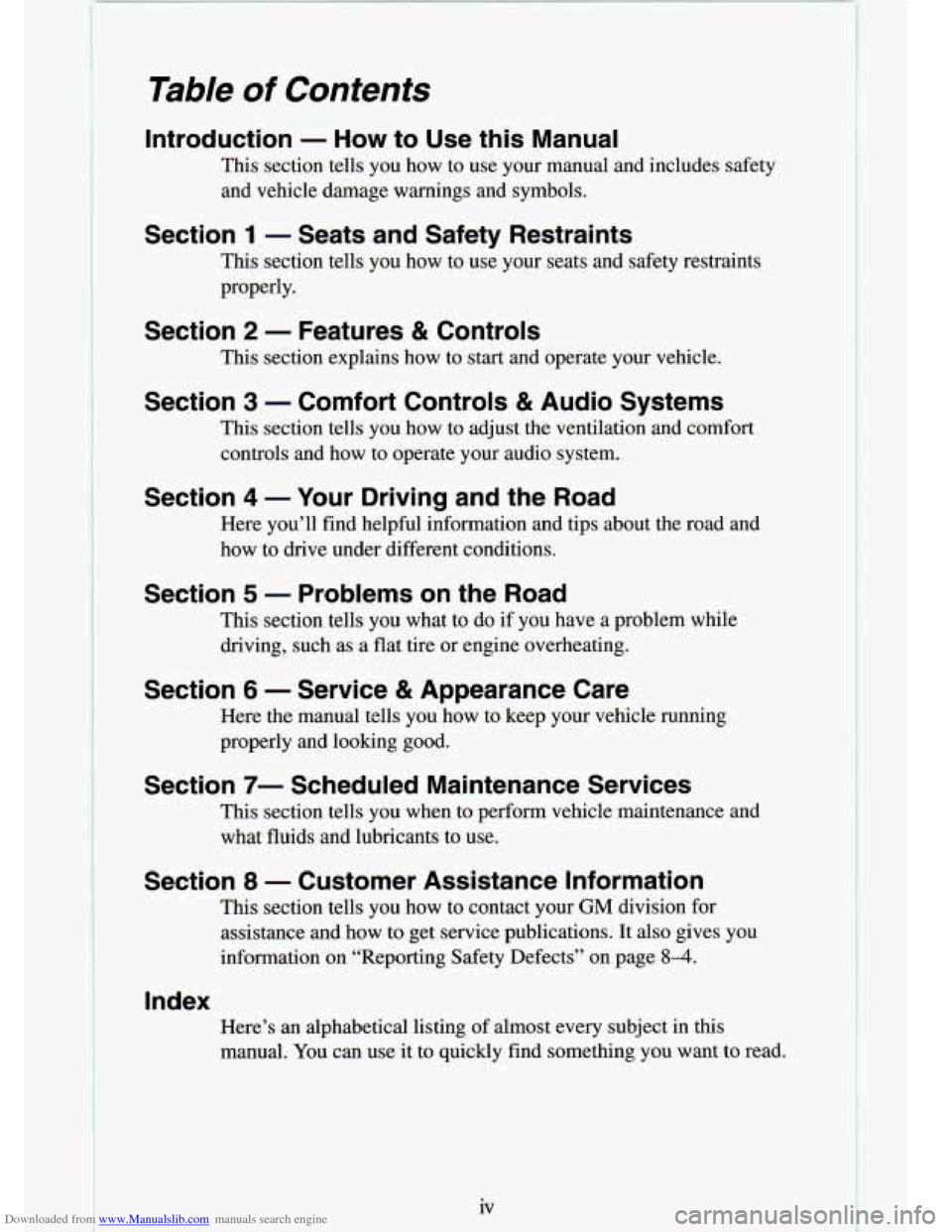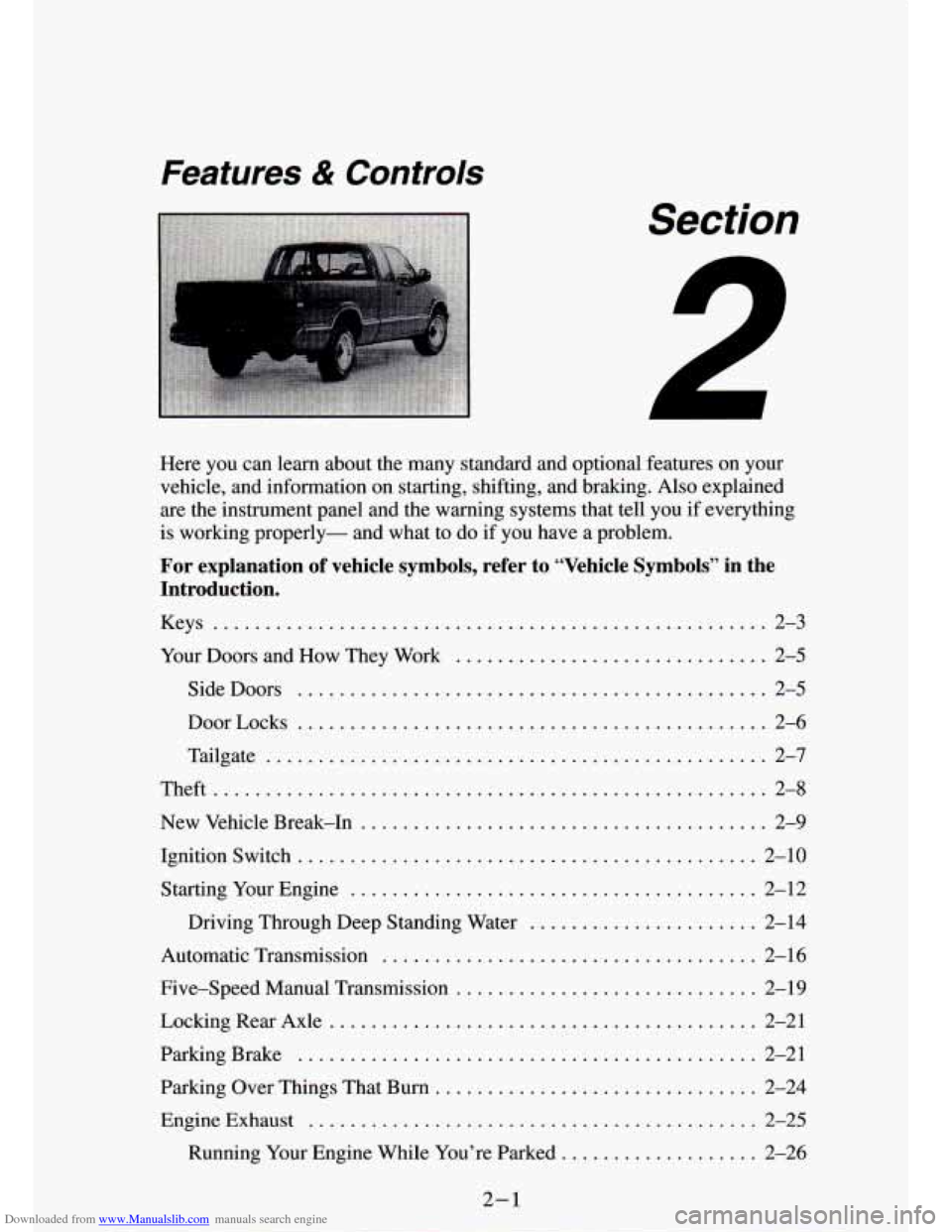Page 6 of 340

Downloaded from www.Manualslib.com manuals search engine Table of Contents
Introduction - How to Use this Manual
This section tells you how to use your manual and includes sa\
fety and vehicle damage warnings and symbols.
Section 1 - Seats and Safety Restraints
This section tells you how to use your seats and safety restraints
properly.
Section 2 - Features & Controls
This section explains how to start and operate your vehicle.
Section 3 - Comfort Controls & Audio Systems
This section tells you how to adjust the ventilation and comfo\
rt controls and how to operate your audio system.
Section 4 - Your Driving and the Road
Here you’ll find helpful information and tips about the road\
and
how to drive under different conditions.
Section 5 - Problems on the Road
This section tells you what to do if you have a problem while
driving, such as a flat tire
or engine overheating.
Section 6 - Service & Appearance Care
Here the manual tells you how to keep your vehicle running
properly and looking good.
Section 7- Scheduled Maintenance Services
This section tells you when to perform vehicle maintenance and
what fluids and lubricants to use.
Section 8 - Customer Assistance Information
This section tells you how to contact your GM division for
assistance and how
to get service publications. It also gives you
information on “Reporting Safety Defects” on page
8-4.
Index
Here’s an alphabetical listing of almost every subject in this
manual. You can use it to quickly find something you want
to read.
Page 8 of 340
Downloaded from www.Manualslib.com manuals search engine ‘I
Safety Warnings and Symbols
You will find a number of safety cautions in this book. We use a box with
gray background and the word
CAUTION to tell you about things that could
hurt you if you were to ignore the warning.
In the gray caution area, we tell you what the hazard is. Then we tell you
what to
do to help avoid or reduce the hazard. Please read these cautions. If
you don’t, you or others could be hurt.
You will also find a circle with a slash through it in this book. This safety
symbol means “Don’t,” “Don’t do this,” or “D\
on’t let this happen.”
vi
.. .
Page 9 of 340
Downloaded from www.Manualslib.com manuals search engine Vehicle Damage Warnings
in this book 3u wi: ind these notices:
I NOTICE:
I These mean there is something that could damage your vehicle. I
In the notice area,
we tell you about something that can damage your
vehicle. Many times, this damage would not be covered by your warranty,
and it could be costly. But the notice
will tell you^ what to do to help avoid
the damage.
When you read other manuals, you might see CAUTION and NOTICE \
warnings
in different colors or in different words.
You’ll also see warning labels on your vehicle. They use yellow for
cautions, blue for notices and the words CAUTION or NOTICE.
Vehicle Symbols
These are some of the symbols you will find on your vehicle. For example,
these symbols are used on an original battery:
Cautran
Possible Injury
Avoid Sparks
or Flames
Protect Eyes
by Shielding Caustic Battery Acid
Sould Cause Burns Spark
or Flame
Could
Explode Battery
vii
Page 10 of 340
Downloaded from www.Manualslib.com manuals search engine These symbols are important for you and your passengers whenever vour
vehicle is driven:
2U
Fasten Safety Door LocwUnlock
Belts
These symbols have to do with your lights:
Master Lighting
Switch Turn
Signal
Direction
**.*:o .e.
Parking Lights Daytime
Running Lights
A
Hazard Warning Flasher
I Fog Lights Headlight
High Beam
viii.
Page 11 of 340
Downloaded from www.Manualslib.com manuals search engine These symbols are on some of your controls:
Windshield Washer Windshield
Defroster Windshield
Wiper
I
Ventilating Fan
These symbols are used on warning and indicator lights:
Engine Coolant
Temperature
BRAKE
Brake Battery Charging
System
I SHIFT
I
Shift Light Fuel
0
Off
Engine Oil
Pressure
Page 47 of 340

Downloaded from www.Manualslib.com manuals search engine Features & Controls
Section
.
Here you can learn about the many standard and optional features on your
vehicle. and information on starting. shifting. and braking
. Also explained
are the instrument panel and the warning systems that tell you if everything
is working properly- and what to do if you have a problem
.
For explanation of vehicle symbols. refer to “Vehicle Symbols\
” in the Introduction
.
Keys ..................................................... 2-3
Your Doors and How They Work
.............................. 2-5
SideDoors
............................................. 2-5
DoorLocks ............................................. 2-6
Tailgate
................................................ 2-7
Theft
..................................................... 2-8
New Vehicle Break-In
....................................... 2-9
Ignitionswitch
............................................ 2-10
Starting Your Engine
....................................... 2-12
Driving Through Deep Standing Water
...................... 2-14
Automatic Transmission
.................................... 2-16
Five-Speed Manual Transmission
............................. 2-19
LockingRearAxle
......................................... 2-21
ParkingBrake
............................................ 2-21
Parking Over Things That
Burn ............................... 2-24
EngineExhaust
........................................... 2-25
Running Your Engine While You’re Parked ................... 2-26
2-1
Page 67 of 340
Downloaded from www.Manualslib.com manuals search engine Four-wheel Drive Vehicles Only: If your vehicle has four-wheel drive
and is equipped with a manual transmission, disregard the shift light when
the transfer case is in
4LO.
Locking Rear Axle
If you have this feature, your rear axle can give you additio\
nal traction on
snow, mud, ice, sand
or gravel. It works like a standard axle most of the
time, but when one of the rear wheels has no traction and the other does, the
locking feature will allow the. wheel with traction to move the vehicle.
Parking Brake
To Set the Parking Brake:
To Release the Parking Brake:
Hold the regular brake
pedal down with your
right foot. Push down
the parking brake
pedal with your left
foot. If the ignition is
on, the brake' system
warning light will
come
on.
Hold the regular brake
pedal down. Pull the
brake release lever.
I
2-21
Page 103 of 340
Downloaded from www.Manualslib.com manuals search engine Trip Odometer
Standard Cluster Tachometer Cluster
I
The trip odometer can tell you how far your vehicle has been driven since
you last set the trip odometer to zero. Make sure the button is completely
depressed.
To set the trip odometer to zero, completely push the button near the
readout.
Tachometer
The tachometer
displays the engine
speed in revolutions
per minute (rpm).
Each tachometer has a different limit depending on the powertra\
in in your vehicle. The tachometer has three areas: normal operating range, yellow
warning range, and’red danger range.
Normal operating range shows your engine speed during normal dr\
iving conditions. For example, when the needle points to
2, it means the engine is
2-57